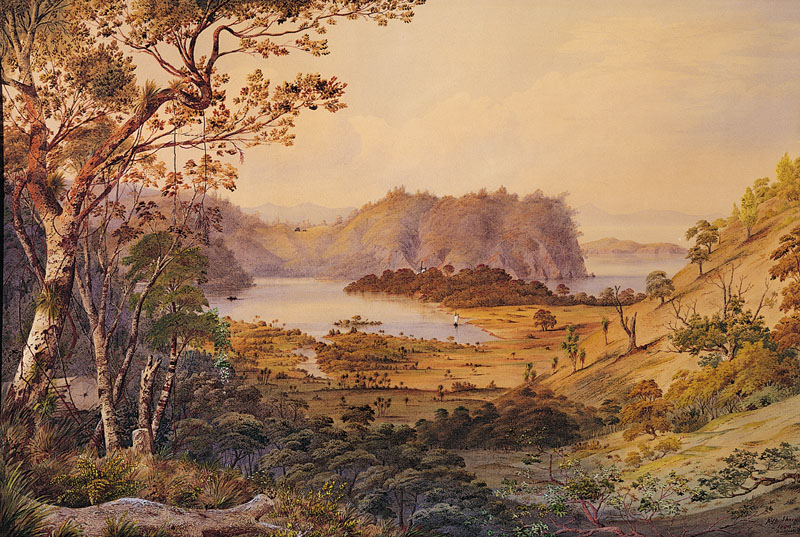SHARPE, Alfred;
Sunset on the Puhoi River
1880
Watercolour on paper
625 x 925mm

The true title of this grand watercolour was discovered by curator Roger Blackley in 1994, when he was conducting research into Alfred Sharpe for a major exhibition of his work. While examining the records of Sharpe’s ‘art unions’, raffles organised as a mechanism for showing and selling his work, Blackley established that Sunset on the Puhoi River, also known as Wenderholm, was the major prize in the first art union, which took place in May 1880. The painting is also one of the artist’s most ambitious.
Innumerable washes of watercolour combine to represent a characteristic North Auckland coastal landscape glowing in late afternoon sunlight. A virtuoso display of technique, the work exemplifies the ‘Hints for Landscape Students in Watercolour’, which Sharpe began publishing in August 1880. These essays appeared weekly in the New Zealand Herald and Auckland Weekly News and provide valuable information about how Sharpe made his spectacular watercolours.
A colour sketch was executed on the spot. A point of view was carefully chosen and the essentials of the scene at a particular time of day laid down on paper. Like many of Sharpe’s pictures, Sunset on the Puhoi River is a late afternoon view, allowing a contrast of shaded foreground against warm, sunlit middle distance. Back in the studio, the outdoor sketch was transformed into an ambitious exhibition watercolour intended to compete with contemporary oil paintings.
Sharpe built the picture gradually, working from the distance (the palest, most translucent zone) towards the foreground. The blended glazes of colour and the more specific brushwork applied over them produce a unified scene. It is the combination of technical brilliance and landscape realism that makes this work so much more than another topographical painting.
Passionately interested in the development of a local landscape tradition, and an early advocate of environmental conservation, Sharpe gave the following advice in the last of his ‘Hints’, published in the Auckland Weekly News of 6 September 1882:
‘New Zealand scenery is special and unique, and, therefore, it is altogether inexcusable to take liberties with it on the pretence of improvement. Leave that to the artists at home, who, painting hackneyed scenery, depend greatly on novelty for effect, and strive to reproduce Nature here as she is, ere her originality disappears before the combined effects of advancing civilisation and imported vermin and vegetation.’
Provenance
1971–
Fletcher Trust Collection, purchased from Cordy’s, Tāmaki Makaurau, 1971
–1971
Unknown
